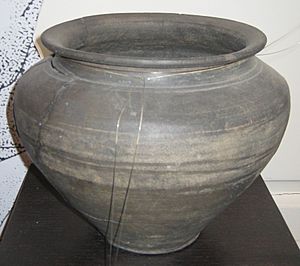Grey ware facts for kids
Grey ware is a special kind of pottery that turns grey when it's baked in a hot oven. People have found this type of pottery in many old sites all over the world. It tells us a lot about how people lived long ago!
Contents
What is Grey Ware?
Grey ware gets its color from the way it's made. The clay used for it is often fired in a special way that limits the amount of oxygen inside the kiln (the oven for pottery). This process makes the clay turn a grey color instead of red or brown.
Where Was Grey Ware Found?
Grey ware has been discovered in many different places, showing how widespread this pottery-making technique was.
Ancient Times: How Old Is Grey Ware?
Grey ware has a long history, going back thousands of years!
Grey Ware in Italy
In Italy, archaeologists have dug up grey ware in places like Antigori and Broglio di Trebisacce. The people there started making this pottery during the Late Bronze Age. That was a very long time ago!
They called this pottery ceramica grigia (grey pottery) on the mainland and ceramica grigio-ardesia (slate-grey pottery) in Sardinia. Even though the pieces found were similar, they also had unique designs. Some experts think that the way Italians made grey ware was inspired by ideas from the Aegean region, which is near Greece.
Grey Ware in Ancient Pakistan
Another example of ancient grey ware comes from Pakistan. It's called Faiz Muhammad Grey Ware. This pottery was made during a time known as the Mehgarh Period V. It included useful items like deep bowls and flat plates. The way this grey ware was made was similar to pottery found in eastern Iran, known as Emir Grey Ware. This shows how pottery-making ideas could travel between different regions.
Medieval Times: Grey Ware in Britain
Grey ware was also popular much later, during the Middle Ages in Britain.
Grey Ware in Medieval Britain
Many types of grey ware were made in medieval Britain, from the late 1100s to the 1300s. Some examples include Hertfordshire-type greyware, South Buckinghamshire pottery, and Limpsfield-type ware. These different types of grey ware show that many potters were making similar items across the country.
See also
- Painted Grey Ware culture of India
- Sandy ware
- Shelly ware


